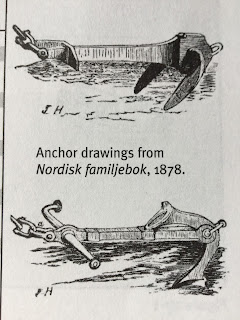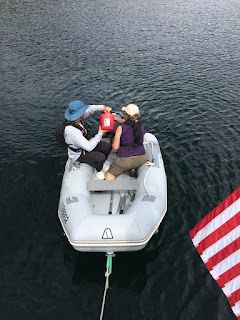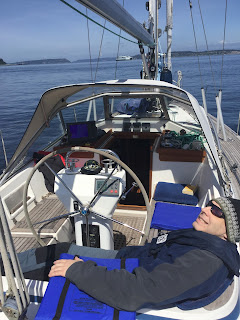An inside Passage trip to Glacier Bay aboard SV Quijote - May 15 through August 27, 2016
May 31, 2016
Day 18- Flora and fauna summary; Bob
Day 17 = Time travel musing; Bob
Day 17 - The Broughtons; Rod
Our days in the Broughtons have been lovely. We entered through Spring Passage on a fine, sunny, windy afternoon after a long day from Port Harvey. Leaving Port Harvey that morning, yesterday it was, we chose to leave somewhat later than usual so that current through Chatham Narrows was at slack. (As a side note… I found it curious that slack in the narrows occurs hours before or after high or low tide. This puzzled me for a while because we're used to thinking of the currents in Puget Sound going slack as flood turns to ebb or visa versa, roughly at a point in time that corresponds to high or low tide. Look for more on the reason this is not so in these channels in a future post.)
Chatham Narrows is, well… narrow, and can be quite shallow, so we wanted to hit it with both depth and slack. We were able to time it so we entered ten minutes or so before slack at about mid-tide height, according to the tide and current tables. Our recorded minimum depth through the narrows was about 28 feet, so there was plenty of room to spare (Quijote draws 6.2'). Kay spotted our 1st grizzly there! It was on the bank some distance away, but it was huge.
There are range markers on the far shore going both directions; it is possible to position the boat in a way that the far and near markers are aligned, one above the other, to keep the boat in the center of the deepest part of the channel. We also put way points in the chart plotter for redundancy.
We glided through the narrows and into Knight Inlet without incident. From there it was a few hours out in the direction of Queen Charlotte Straight, dodging Islets with a 15 knot wind on our nose all the way.
We intended to spend three nights in the Broughton archipelago on our way through to Queen Charlotte Sound, but since the weather is looking favorable for getting around Cape Caution, we decided to bank a day and just spend two. The first was in Wadington Bay where it started off quite windy, but settled down as the evening wore on. The book described the anchorage as protected in all directions, but it didn't feel that way at first.
There was a large cabin cruiser anchored near the entrance to the bay and we thought it an odd choice of places to lower their anchor, since there are better, more protected corners of the bay available, but eventually we came to the conclusion that they chose the spot for the convenience of getting their dog ashore.
Our furst full day in the Broughtons, we were witness to a wonderland of tiny islands, remote craggy rocks, boundless forested hillsides, with occasional evidence of logging, aquaculture, and many crab pot buoys scattered about the marinescape.
We targeted Claydon Bay for the second night's anchorage, but noticed a small trail in the description for the Turnbull Cove, so we made a temporary stop to stretch our legs. The trail was short and sweet to a small dock with a picnic table on a picturesque lake. Kay found an abandoned paddle board and paddled around the lake for a while; Bob and I poked around in the woods along the shoreline enjoying the time on terra-firma.
Returning to Quijote, we found the cabin cruiser had followed us, again anchored near the entrance to the bay. We were half tempted to leave Quijote where she was, since the day was sunny, calm and quiet, and the boat was already anchored. But tomorrow was to be a long day and we'd be adding to that by staying put. The book also promised wildlife in Claydon Bay in the form of loons, herons and seals.
So we moved the boat and were quite pleased we did because we had red breasted loons, bald eagles, seals, and ducks to share the anchorage with, but no other boats. The loons clucked away in pairs, but started up a chorus of wailing when a bald eagle or a hawk flew overhead. The evening was warm and the water glassy as we enjoyed a meal of barbecued sausage, mashed potatoes and veggies, with a variety of bird calls filling the air around us. Perfect.
Day 14 - Slaying Dragons; Rod
It's a funny fact of recreational life that the better you prepare for slaying dragons, the fewer dragons there will be to slay. I guess that's another way of saying that the best way to beat dragons is to avoid them.
Reading about the lives that have been lost in Johnstone Straight, it's hard not to be intimidated by the idea of navigating through it. We're told to avoid large currents, large tidal exchanges, shoals, tugs, barges, heavy weather, spring tides, opposing wind and current, turbulence, and sea monsters. In crossing Seymour Narrows yesterday and Johnstone Straight for seven hours today, we avoided all of it - partly by luck and partly by doing our homework.
The first point of luck was high tide, 7am at Chatham Point on a day with relatively small tidal exchanges. Granted we might have chosen a different day if things had not been aligned so nicely. High tide allowed us to drag our buts out of bed at 6am and put ourselves in position to ride the ebb all the way to anchorage.
The second stroke of luck was a light to moderate SE wind that flowed in the same direction as the current. We even had the sails cranked out for a while.
We started the day in heavy rain and ended it in sunshine, at times fished through choppy turbulence and then glided across glassy water. We gave way to three tug and barge combos steaming down the straight in tandem, and later had the passage to ourselves. We motored and sailed, shivered and baked, ate well and socialized.
All the while we kept eyes out for dragons where none appeared. Yay verily.
May 30, 2016
Day 16 - Anchorage memories; Kay
Day 16 - Word games; Bob
May 29, 2016
Day 15 - Resource-based economy; Bob
May 28, 2016
Day 14 - Sancho Panza awakens on Quijote; Kay
May 27, 2016
Day 13 - Campbell River recharge; Bob
May 26, 2016
Day 12 - Moron Anchoring; Rod
It’s great to arrive at an anchorage early in the day. Not only does it simplify the job of anchoring with fewer boats around to consider, but it gives us the opportunity to watch other boats go about the task as they arrive. Some make us want to cringe; others we can learn from.
Day 12 - Hike to Black Lake; Bob
May 25, 2016
Day 10 - Malaspina Solitude; Rod
Day 10 - Shout out to Tina; Bob
Day 10- Hallberg-Rassey; Bob Bennett
May 24, 2016
Day 8 - Ode to a Dinghy; Bob
May 23, 2016
Day 8 - Recon gone amuck; Rod
Day 7 - Provisioning; Kay
Day 7 - Stern Tie; Bob
May 22, 2016
Day 7 - On Land Recreation and alternate uses of teapots; Rod
Day 6 - Anchoring in Princess Louisa Inlet; Rod
Day 5 - Imaginary Thieves and Real Military; Rod
Day 5 - Wine Hitch; Bob
May 20, 2016
Day 5 - Marine Perspective; Bob
May 19, 2016
Day 4 - Plotting our course; Bob
May 18, 2016
Day #3, Nesting Birds - Kay
We anchored at Silva Bay this afternoon. Silva Bay is a sweet spot off the east side of Gabriola Island. After taking the dinghy to town, well not town, really just the marina and some services, we are back on Quijote safe and sound. Lucky we didn't stay off board for a beer. We are sipping beers while snug in the cockpit with winds increasing to 14 knots, and gusts thus far up to 19 knots!
Enroute today we had time to waste before slack at Gabriola Passage. We choose to drift gently, no motor, no sails, along Valdez Island 100 yards offshore where we watched and listened to nesting birds, soaring eagles, sleek seals. A special treat.
Motoring through Gabriola Passage at slack was a breeze.
After another long day, we all look forward to a long sleep. Tonight it will be to the sound of howling wind and hard rains cleansing the decks.
Day 2 Avocado madness; Rod



Day 1, Aleck Bay; Rod
May 15, 2016
A fine send-off
It is quiet. Drizzle has settled in. The distant trees have softened edges. Everywhere is light greyness. Gentle rain on the dodger. Dusk. A perfect first night on Quijote.
May 4, 2016
Food preparation
Kay has been organizing a list of what food items are needed for the big sailing trip up the Inside Passage. Importantly she has assigned meals that each of us are responsible for. Rod lent one me one of his two vacuum sealing machines and I am busy cooking meals that should be welcome fare up North. The idea is to have meals that can be easily prepared while sailing. In the photo you can see a home prepared meal that is about to be vacuum sealed!
May 2, 2016
Second of Two Crew Preparation Cruises
We transited the locks in short order on Saturday morning and motored North past the south end of Whidbey Island dodging regatta boats that were floating aimlessly in the slack early morning wind. Abreast of Everett the winds started to build until we were snorting along at over six knots under jib and mainsail.
Wanting to arrive at Langley before the marina office closed at 5, we used up our play time and headed in to dock and explore the town.
Langly has a small town feel to it, but the general store has ample provisions and the dock has great WIFI. We stopped at a small beverage cafe to unwind a little and then found a trail down to the beach to get a little walking in.
Saturday was all about giving the crew time to become acquainted with Quijote and her various systems. For lunch, Lavanya and Jason put together awesome grilled sandwiches and salad and we barbecued chicken on the stern rail for dinner. The new griddle Kay added to the galley works really well.
Sunday started by anchoring outside the marina and, with more great cooking by the Lavanya-Jason duo, Bruce and I worked though the dinghy deployment and used the new outboard hoist to mount the outboard onto the back of the dinghy. With a few practice runs of the dinghy around the boat, we filled our bellies with the fruits of L&J's efforts: a mushroom cheese scramble and toasted bread, granola, fruit and yogurt. Awesome!
After a little attention to some odds and ends, jack lines, man overboard procedures, etc, We were under way again with a galloping 16 knot following wind - great conditions for spinnaker sailing!
Photos by Rod and Lavanya








































